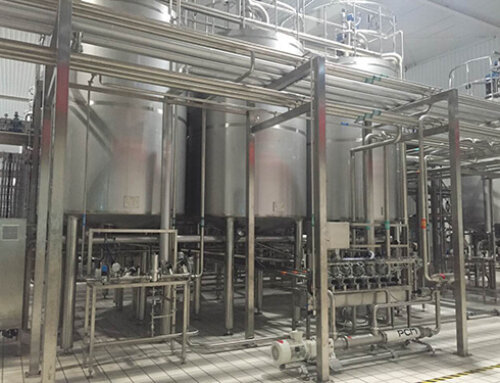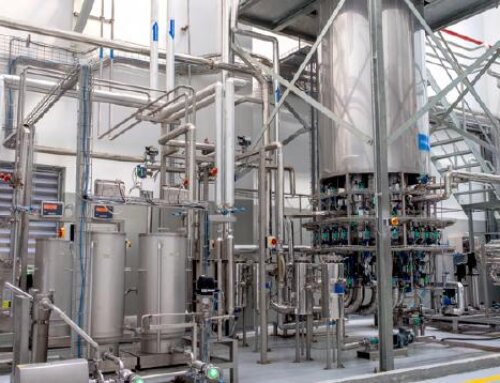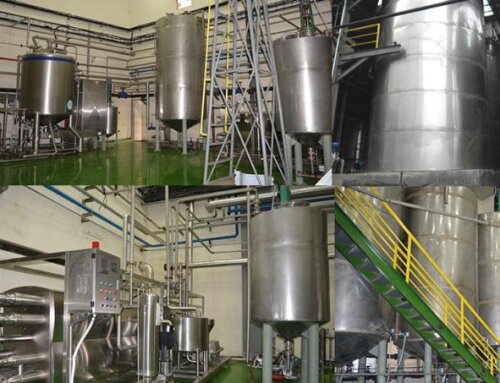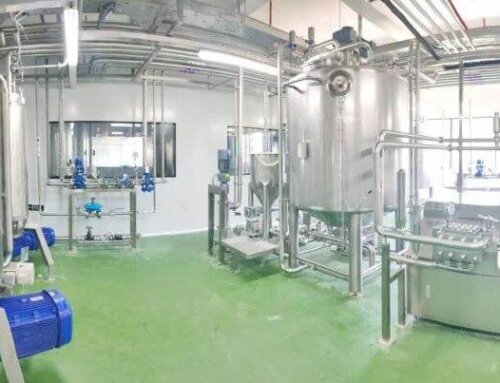Juice milk beverage refers to a milk-containing beverage prepared by adding fruit juice, sugar, organic acid, stabilizer, etc. to fresh milk or skimmed milk powder. It has the characteristics of bright color, aromatic taste, sour and refreshing taste.
The capacity of milk juice beverage processing is from 500L/H-10000L/H, and the most popular package for juice milk products is bottles, cartons and pouches.
The whole milk juice processing line is made of SUS304 material and equipped with CIP cleaning system to ensure the hygiene condition when production.
Juice Milk Beverage Processing Technological Flowchart
The whole line includes fruit juice preparation system, milk receiving and preparation system, juice, milk and ingredients formulation and blending system, juice milk beverage pasteurizing/sterilizing system, filling and packing system, CIP system, and RO water system.

Milk and juice preparation system
There are two type of materials for preparing fruit juice and milk:
The first method is using fruit juice concentrate and milk powder as raw ingredients, we use the water powder mixer to dissolve the milk powder into liquid then mix with water and juice concentrate to make the milk juice drinks.
The second method is use fresh milk and fresh fruits as raw materials to make into fruit juice and pasteurized milk, with this method, there are two systems:
- fruit juice preparation system: The fresh fruits and vegetables preparation system involves in fruit selection, washing and sorting, pre-cooking, peeling, seeding and pitting, crushing and pulping, and squeezing and separating to obtain fruit juice.
- milk receiving system: The fresh milk will be received, weighed, filtration and standardizing, milk separating and storage system.

Juice milk formulation
The beverage formulation process is completed in the blending tank. The stabilizer and sugar solution is added to the raw milk and fruit juice in the blending tank, mixed evenly, and cooled. The stabilizer should be added before the acidifier, otherwise, there will be no protective effect of the stabilizer, and the milk protein will form particles of uneven size, making the end product not stable enough.

Juice milk Homogenizer
Homogenization can give full play to the effect of the stabilizer, reduce the particles of fruit and vegetable juice, prevent protein precipitation, thereby improving the taste of the product and increasing the stability. The homogenization temperature and pressure is 65°C/15-20Mpa.

Juice milk Sterilization/pasteurization
For aseptic carton packaging, the sterilization process at 105-115°C and holding for 15-30S can be used. For hot-filled bottled fruit juice milk beverages, they can be pasteurized and then hot-filled into the bottle, secondary sterilization and cooling.

Juice milk filling and packing system
The milk juice beverage is filled into bottles, cans, or cartons, and sealed to prevent contamination. Labels are applied, and the products are packed into cartons or wrapped into film for distribution.

Juice Milk Beverage Processing Formula Reference
In order to make fruit juice milk beverages have a refreshing flavor, the content of milk fat and milk solids should be reduced. The content of each component of fruit juice milk beverages is 0.3% fat, 10% sucrose, 1.2% protein, acidity 0.36%-0.38%, and pH 4.6- 4.8
| Ingredients | Percentage |
|---|---|
| Milk Powder | 3%-15% |
| Sodium Citrate | 0.2% |
| Concentrated Juice | 2%-10% |
| Sugar | 7% |
| Stabilizer | 0.25%-0.6% |
| Flavor&Color Agent | 0.1% |
| Water | 80% |
Juice Milk Beverage Raw Ingredients
- Fruit and vegetable juice
Fruit juice milk beverages often use orange juice, tomato or carrot juice, pineapple juice, apple juice, pear juice, etc., and there are also compound juices. The general raw material is concentrated juice, and there are also NFC juices as raw materials. In order to prevent the pulp from settling, after squeezing the juice, a centrifugal separator or filtering equipment is required to obtain a transparent juice. NFC juice raw materials retain more flavor and nutrients than concentrated juice.
- Milk raw materials
The milk raw materials can be fresh milk, condensed milk, whole milk or skimmed milk powder, etc., and one of the raw materials can be selected separately or used in combination. Fresh skimmed milk or skimmed milk powder is often used as it can prevent the appearance of fat circles in the product.
- Stabilizer
The isoelectric point of casein is pH4.6, while the pH range of fruit juice milk beverage is 4.5-4.8, in this range milk protein will coagulate and precipitate. It is usually solved by homogenization and stabilizer. The commonly used stabilizer for clarified fruit juice is gelatin, and the commonly used stabilizer for turbid fruit juice is pectin, alcohol ester, etc.
- Sour agent
The products produced by lactic acid have the best quality, but because lactic acid is a liquid, it is inconvenient to transport, and the price is high. Generally, citric acid, lactic acid, and malic acid are used together. In actual production, the dosage can be adjusted according to the formula. When adding, the organic acid is first made into a 2%-3% acid solution, and it needs to be stirred continuously when it is added to the blending tank.
- Sweetener
Adding a certain amount of sucrose to the milk-containing juice beverage can improve the flavor and prevent precipitation. Sucrose can also increase the density of the beverage and increase the viscosity, so that the casein particles can be uniformly and stably distributed in the beverage to form a suspension and the beverage is not easy to settle. You can also add cyclamate, xylitol and other sweeteners to replace part of the sugar.
- Colorants
Coloring agents are mainly used to increase the hue of fruit juice milk beverages, increase the value of commodities and appetite. When juice is added to the milk component, it is easy to form a mid-tone. Because the color is not clear, it is necessary to add a coloring agent. Commonly used pigments are carotene, gardenia red and turmeric.




